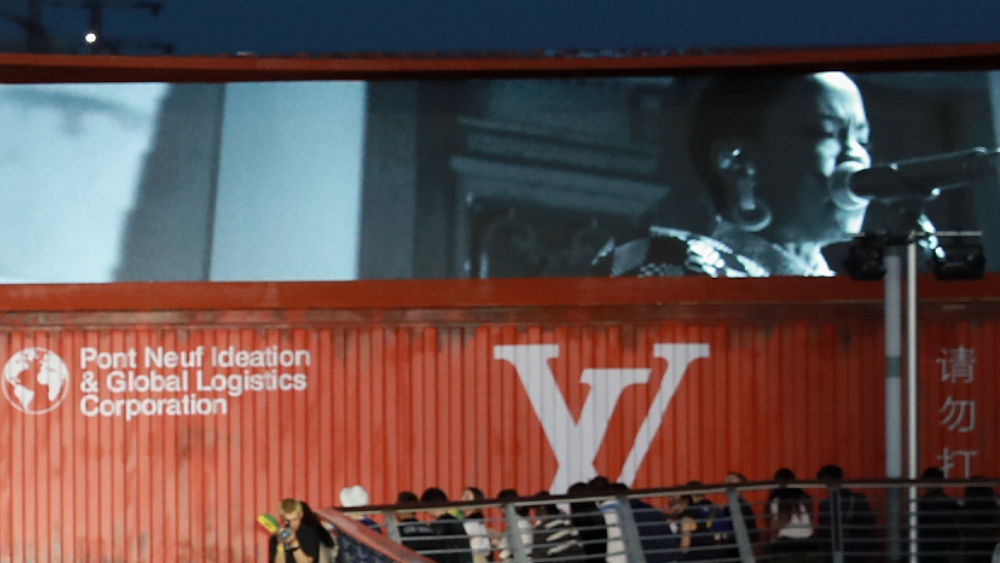If you’re interested in sharing your opinion on any cultural, political or personal topic, create an account here and check out our how-to post to learn more.
____
Set on a harbor dock, surrounded by orange freight containers adorned with the Louis Vuitton (LV) logo and various large blow-up LV renditions of Zoooom with Friends placed around, Louis Vuitton premiered its Men’s Spring-Summer 2021 show. The show took place in Shanghai, China, and showcased 59 looks that were stunning, abstract and eclectic. Each look displayed and played with texture, silhouette and structural design, which all encompassed the Zooom with Friends motif. It was beautiful, interesting and futuristic, to say the least.
Nonetheless, outside of the clothing choices and structural designs of the pieces, another vital aspect of the show was the music selection. During the first half of the show, LV utilized instrumental soundtracks that were calm; however, around 13 minutes and 31seconds into the show, Lauryn Hill emerged on a screen within one of the sides of a freight container. When Hill appeared, the tempo and feel of the whole show changed completely. An upbeatness and timber encapsulated the show with Hill.
Hill performed several tracks from her album, The Miseducation of Lauryn Hill, and a few new songs with a live band. The show transformed from a high fashion runway show to a visual and auditory masterpiece of emotion.
It makes total sense why Louis Vuitton Men’s creative director, Virgil Abloh, chose to debut his Louis Vuitton Men’s Spring-Summer 2021 show in Shanghai, China, as China is the leader in buying luxury goods. It also makes sense to give a stage to the Black experience in a space it is often not represented. Moreover, at first glance however, when you begin to hear Lauryn Hill perform, the show seems to be disjointed. But upon further examination, you realize that it has a rhyme scheme. It becomes very evident as the show goes on that there was an open and clear political statement being created and debuted by Abloh.
In his own words, Abloh chronicled the show as not "just a mere musical performance or another fashion show — what you've seen is Black imagination manifesting itself in real life.” I could not agree more.
In the wake of the Black Lives Matter (BLM) movement in the United States and around the world, many have pressured brands to come out with their stance on how they feel about Black bodies and their importance. Louis Vuitton, a member organization of the conglomerate LVMH, did not speak out much about the BLM movement. Many thought this was an odd choice, considering Virgil Abloh (a Black man) is the Men’s Creative Director for Louis Vuitton. However, that all might be changing with this show.
Thus, seeing Louis Vuitton through Abloh’s eyes makes such a strong statement about Blackness and its imaginative abilities. At the end of the show, Abloh and Hill brought the audience’s attention to the fact that Louis Vuitton would be making a donation to the MLH Foundation "with all proceeds going to Black businesses affected by COVID-19 and other hardships." If anyone ever tells you fashion should not be political or socially conscious, they do not understand the art form and industry.
Abloh and Hill’s symbiotic work throughout this show will most likely stand as a pillar as the most political, visceral and honest show of 2020. Louis Vuitton’s show, in my opinion, will serve as a reminder to the rest of the fashion industry’s new and old guards that fashion is inherently political — and that needs to be remembered. This show’s power lies in the way that it politicizes fashion, in a manner that reminds people that fashion can impact society, policy and structures if we as consumers, and the industry, let it. I hope that brands and consumers see this show as a wake up call for what is possible.
Other brands need to take note and realize that you do not have to be performative to show allyship. You can be wholly authentic. Brands have the ability to be political and impact change for communities like the Black community if it is willing to take risks, care about the clothing and think strategically about the messages it wants to send.
While there is still much work to do, Abloh and Hill have provided a masterclass in how to begin an important, albeit difficult, conversation through fashion. Hopefully other brands see this moment as a vehicle to do better and create more racially and socially inclusive narratives in their brands and work.
